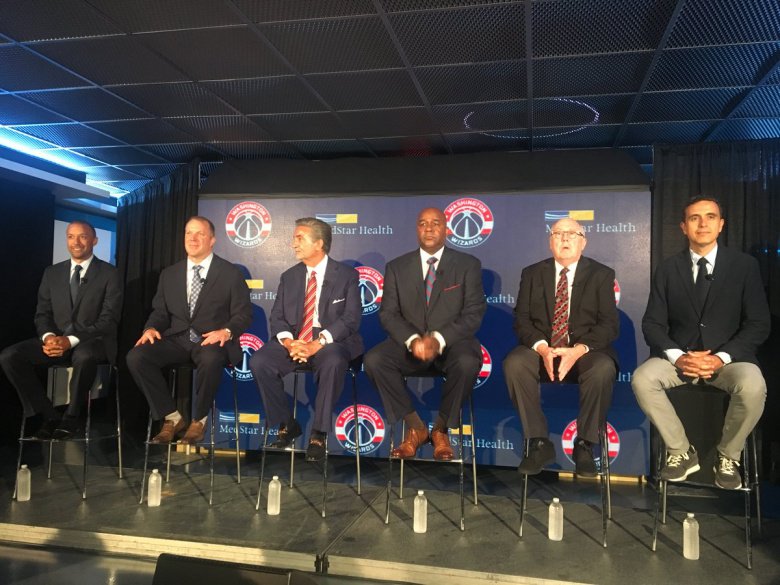Wizards leave shallow end for deep dive in new structure

By DERON SNYDER (as published in The Washington Times)
Having taken nearly four months to find a replacement for Ernie Grunfeld, Washington Wizards owner Ted Leonsis proved he wasn’t following the traditional path.
Now, with the announcement of several new hires and roles within the organization, the extent of Leonsis’ unconventional thinking is clear: He didn’t just want a new builder to lead the front office.
He wanted a totally new blueprint for the front office.
In Brooklyn, Los Angeles, New Orleans, and other outposts, NBA fans are excited about big-time players acquired via free agency, trades or the draft. They’re envisioning how the additions fit into new starting lineups. They’re contemplating how the revamped rotations might look.
In D.C., we’re left to digest the Wizards’ new org chart.
That’s not nearly as flashy or appealing, but it’s a start. At least Leonsis has taken the first step (second if you start with dumping Grunfeld) in the however-long journey toward title contention.
In removing the interim tag from general manager Tommy Sheppard, while hiring former Cleveland Browns executive Sashi Brown, former Georgetown coach John Thompson III and former Philadelphia Sixers/FC Barcelona team physician Daniel Medina, Leonsis wasn’t thinking outside the box.
He was thinking far outside the four walls surrounding the box.
“We have formed a new leadership team with a forward-thinking structure to adapt to the ‘new NBA’ that requires every possible strategic advantage to compete and win,” Leonsis said in a statement. “We are building a leadership brain trust with deep Wizards/NBA experience and with sports professionals from inside and outside the NBA to challenge our thinking and adapt to an ever-increasing competitive environment.”
Sounds great, though there’s no telling how successfully it will work. Then again, the same could be said if Leonsis stuck with the conventional approach.
The new construct is bound to induce eye-rolling among some observers, convinced that it’s nothing more than new-age gobbledygook designed to deflect attention from the team’s long-established backward ways. Brown likely is to blame for a large portion of that skepticism. Reasonable people can wonder why Leonsis hired an executive whose tenure with the Cleveland Browns was a 1-27 monstrosity.
It should be noted, however, that Cleveland won just three games in 2015, the season before Brown arrived. The team lost at least 11 games in six of the prior seven years. Yes, the record was even worse during Brown’s brief stint. But he tilled the soil that produced the draft picks and salary cap space, giving successor John Dorsey ingredients to whip up a contender.
The fact that Brown hails from the NFL could generate more cause for apprehension. But crossover executives have worked before. Cleveland hired Brown and former MLB general manager Paul DePodesta as a package deal, and the latter remains employed as the team’s chief strategy officer. It appears that Brown will hold a similar role – chief planning and operations officer – with the Wizards.
Brown also won’t be the first D.C. sports executive with experience in multiple pro leagues. The poster boy is Stan Kasten, former president of the Nationals and Atlanta Braves, current president of the Los Angeles Dodgers. Only the NFL is missing from Kasten’s resume; he formerly served as general manager of the Atlanta Hawks (NBA) and president of the Atlanta Thrashers (NHL).
Brown’s handling of technology, finance, communications, security, research and player engagement shouldn’t conflict with Sheppard’s responsibilities regarding player personnel and coaching. Sheppard’s work in rebuilding a roster that includes just three rotational players from last year has been commendable, even though next season’s won-loss record will be brutal.
The keyword moving forward for Leonsis is “collaboration.” He figures that it can’t hurt to have more smart people involved in the decisions, and he’s correct – as long as they truly work together with little concern for who gets the credit (or the blame).
In a video, Leonsis said he spoke to more than 50 people from the NBA and other major leagues, looking for best practices of the best organizations, “to try to find the right solution and right answer for us on a new organization. I felt we needed to inject a massive amount of change, but also focus on getter deeper in our basketball knowledge and skills.”
Can’t argue with that assessment after the Wizards’ 40 years mostly in the shallow end of the pool.
With this restructuring, Leonsis isn’t simply rearranging deck chairs. He’s providing hope for smoother sailing ahead with a talented crew in the chart house.
Granted, it’s a poor substitute for #KD2DC.
But it’s way better than nothing and possibly really, really good.
— Brooklyn-born and Howard-educated, Deron Snyder writes his award-winning column for The Washington Times on Tuesdays and Thursdays. Follow him on Twitter @DeronSnyder.
 Follow
Follow
